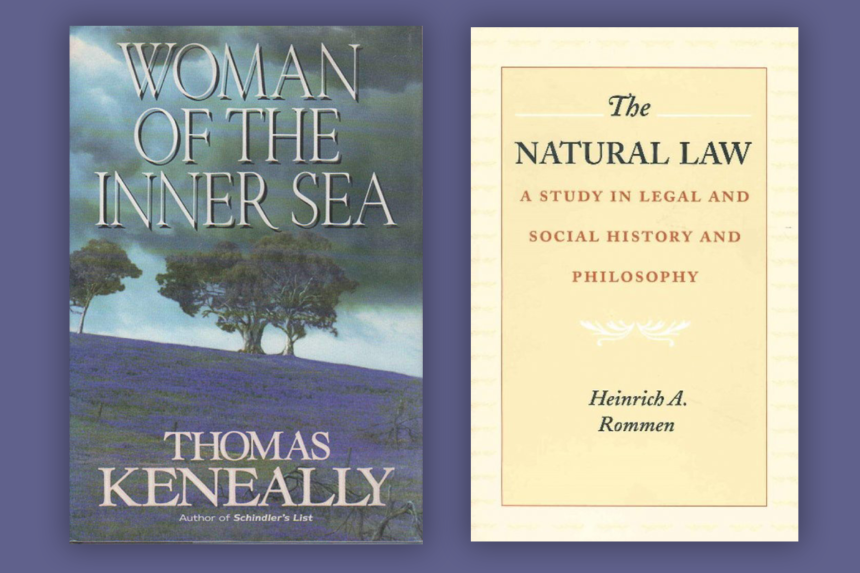The plot of the Woman of the Inner Sea may strike one as interesting for a children’s book: An Australian woman leaves Sydney incognito for the interior and makes friends with a kangaroo and an emu. But Thomas Keneally’s novel is for adults and contains a complex structure, a rich cast of characters, and nuanced probing of serious matters.
Keneally is widely admired as the author of Schindler’s Ark (1982), the basis for the prize-winning film Schindler’s List. His depiction of Australia, both authentic and exotic, vibrates with devotion to his homeland and its people. The settings—the Sydney suburbs and seacoast, a railway hotel, the outback, a flooded landscape in an ancient seabed—are appealing by both their distance and time lag. His characters include an amiable priest known for drink and gambling, who is as memorable as Graham Greene’s clergyman in The Power and the Glory, though more attractive.
To Keneally’s strong renderings of places and people is added his particular narrative method, obscuring our view of the characters, which are fascinating or vexing, according to one’s taste. Instead of laying out his premises directly, introducing characters fully in the Balzacian manner, and moving straight through events, Keneally begins with limited information and leads readers through complicated retrospective scenes with only fragmentary information.
The novel is “maddeningly elliptical,” Library Journal’s reviewer wrote. “It takes forever to discover the tragedy of Kate’s life.” Well, isn’t that also frequently true of the real people we meet in life?
Keneally draws attention to the fictional nature of the story by referring to the main character as “the Kate of our story” and addressing readers as “Dear Bookbuyers,” as if they were his collaborators or aspects of himself. Authorial intervention, a device dating from the 18th century, used sparingly in the 19th, and popular with the avant-garde in the 20th, does not appeal to those who want the novelist to follow the Flaubertian rule: to be “present everywhere, visible nowhere.” Keneally’s wry, engaging addresses emphasize that a novel is an invention demanding an audience. He teases us the way real-life acquaintances conceal or scatter crucial evidence, carelessly or half-aware. What he tells us often underlines not what was, but what might have been.
—Catharine Savage Brosman

“Academics repeatedly declare the natural law to be dead,” observed former Notre Dame law professor Anton-Hermann Chroust. “But every twenty-five years or so it comes in again by the back door when some crisis shows the failure of utilitarian positivism.”
America seems to be at such a crisis point, with the dominance of “wokeism” and the lack of intellectual confidence of the polity in knowing—among other things—that a boy is a boy, and a girl is a girl. What was once the preserve of the asylum is now given force of law through the various civil rights acts and the myriad of federal, state, and local policies that impose a worldview younger than most of the people it impacts.
Given the effect of this totalitarian impulse on the American scene and, particularly, its dominance on the law and public policy, it behooves us to return to a neglected part of the library and dust off a copy of Heinrich Rommen’s The Natural Law: A Study in Legal and Social History and Philosophy (1936).
Rommen’s brief is both historically comprehensive and philosophically profound. He traces the idea of natural law from the first recorded ruminations of man through the modern triumph of positivism. In a profoundly intellectual analysis that buttresses Chroust’s claim, Rommen demonstrates the reappearance of natural law with a critique of the theories of leading legal scholars.
Of course any theory of law that challenges the will to power of the secular totalitarian state is bound to be unwelcome. Hence Rommen’s escape from Nazi Germany to the United States in 1938 after the book’s initial publication.
One of the book’s most poignant contributions to jurisprudential thought is the observation that law must be rooted in metaphysical convictions. In order to critique the state or the laws of a nation, one must have a higher standard by which those can be measured. This higher standard must terminate in an ultimate being, Rommen argued. Likewise, an epistemology grounded in recognition of this higher being would serve as a corrective to the overactive imaginations of today’s “woke.”
It might be too much to expect consideration of these questions by the contemporary legal community. It might be too uncomfortable for our law students, lawyers, and government officials to realize that there are limits in imposing one’s will. And therein lies the rub: lawyers should defend limits, not remove them. Unfortunately, this is not the case in law schools or government. Rommen’s classic is a corrective to the current stupidity.
—John M. DeJak

Leave a Reply